Impact of Commodity Prices and Stock Markets on Global Macroeconomics
VerifiedAdded on 2023/06/12
|9
|2417
|419
Essay
AI Summary
This essay examines the impact of rising commodity prices and stock market performance on global macroeconomic conditions. It discusses how rapid expansion in developing countries leads to increased commodity prices and inflationary pressures, necessitating fiscal policy interventions. Additionally, the essay analyzes the effects of rising stock markets in developed economies, highlighting the role of monetary policy in managing inflation and maintaining economic stability. The study concludes that macroeconomic policies, both fiscal and monetary, are crucial for addressing economic challenges and ensuring overall stability in both developing and developed nations. Desklib provides students access to similar solved assignments.
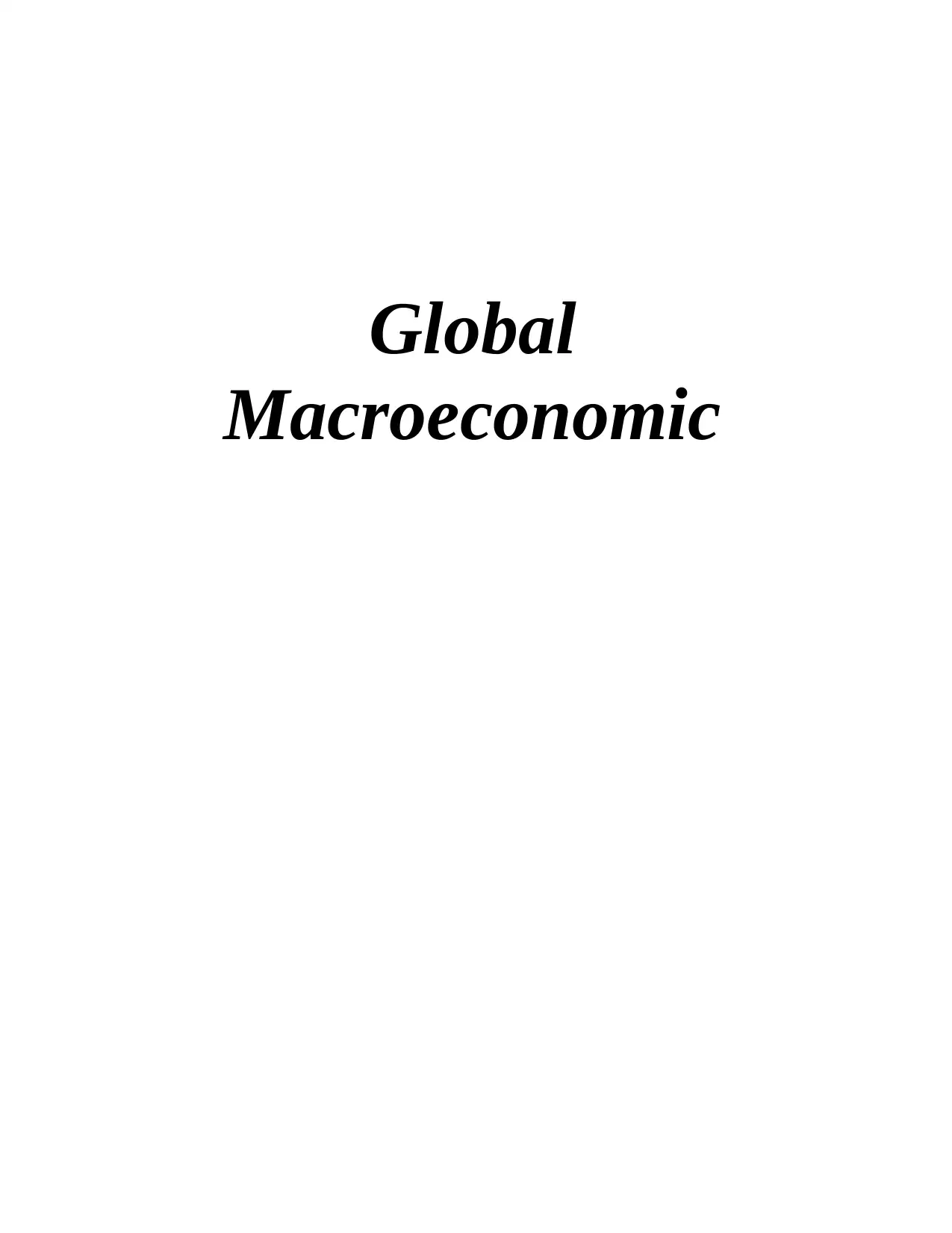
Global
Macroeconomic
Macroeconomic
Paraphrase This Document
Need a fresh take? Get an instant paraphrase of this document with our AI Paraphraser
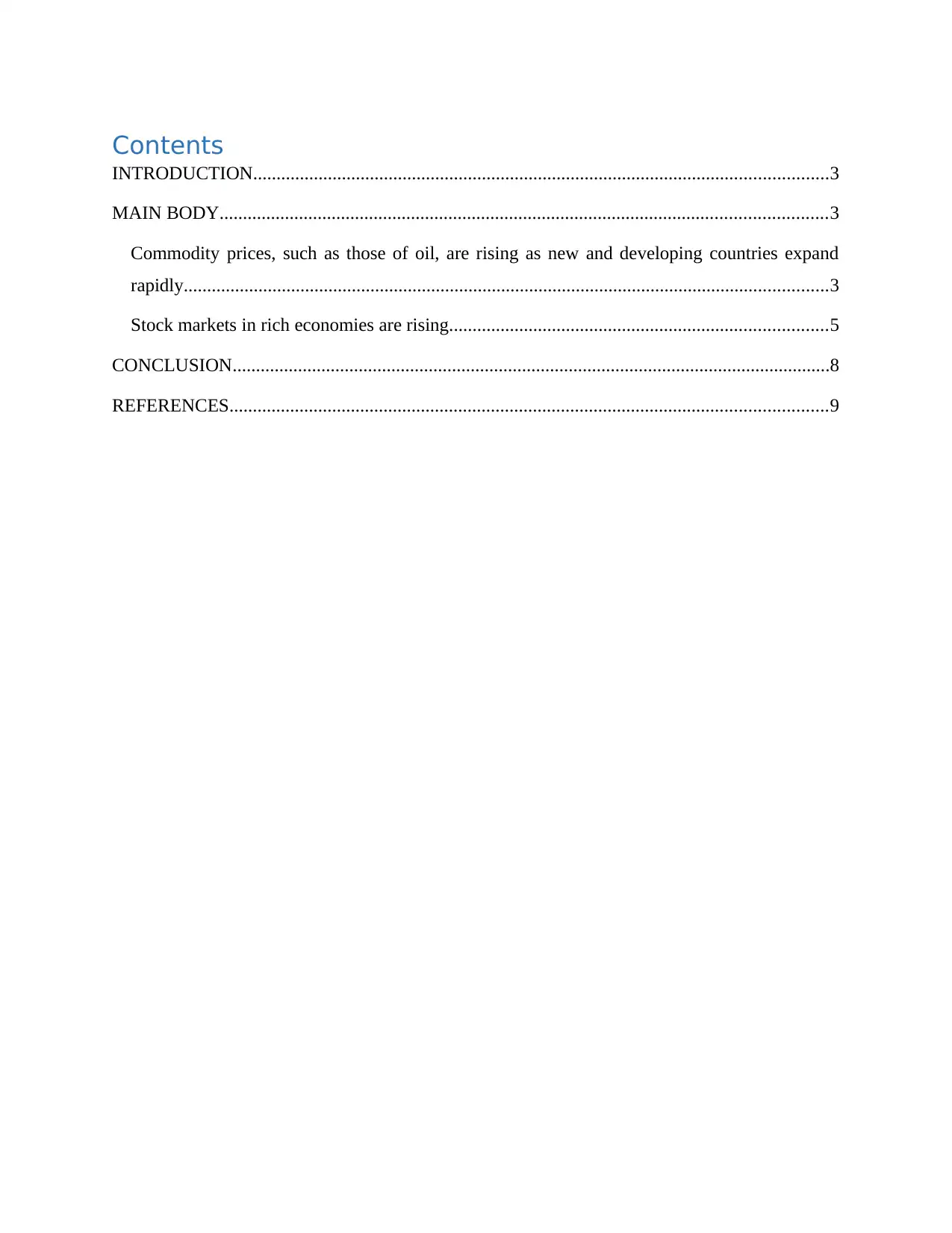
Contents
INTRODUCTION...........................................................................................................................3
MAIN BODY..................................................................................................................................3
Commodity prices, such as those of oil, are rising as new and developing countries expand
rapidly..........................................................................................................................................3
Stock markets in rich economies are rising.................................................................................5
CONCLUSION................................................................................................................................8
REFERENCES................................................................................................................................9
INTRODUCTION...........................................................................................................................3
MAIN BODY..................................................................................................................................3
Commodity prices, such as those of oil, are rising as new and developing countries expand
rapidly..........................................................................................................................................3
Stock markets in rich economies are rising.................................................................................5
CONCLUSION................................................................................................................................8
REFERENCES................................................................................................................................9
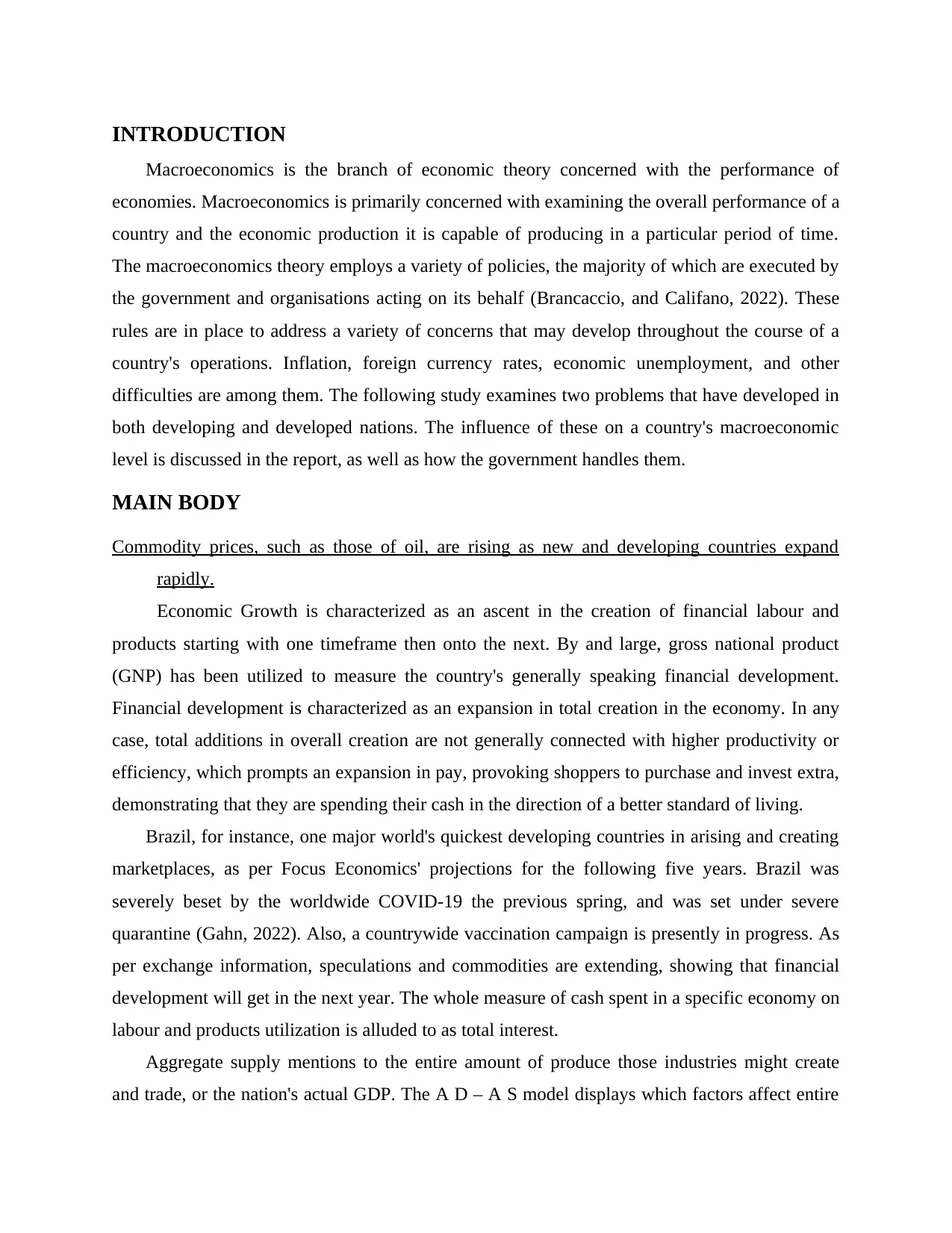
INTRODUCTION
Macroeconomics is the branch of economic theory concerned with the performance of
economies. Macroeconomics is primarily concerned with examining the overall performance of a
country and the economic production it is capable of producing in a particular period of time.
The macroeconomics theory employs a variety of policies, the majority of which are executed by
the government and organisations acting on its behalf (Brancaccio, and Califano, 2022). These
rules are in place to address a variety of concerns that may develop throughout the course of a
country's operations. Inflation, foreign currency rates, economic unemployment, and other
difficulties are among them. The following study examines two problems that have developed in
both developing and developed nations. The influence of these on a country's macroeconomic
level is discussed in the report, as well as how the government handles them.
MAIN BODY
Commodity prices, such as those of oil, are rising as new and developing countries expand
rapidly.
Economic Growth is characterized as an ascent in the creation of financial labour and
products starting with one timeframe then onto the next. By and large, gross national product
(GNP) has been utilized to measure the country's generally speaking financial development.
Financial development is characterized as an expansion in total creation in the economy. In any
case, total additions in overall creation are not generally connected with higher productivity or
efficiency, which prompts an expansion in pay, provoking shoppers to purchase and invest extra,
demonstrating that they are spending their cash in the direction of a better standard of living.
Brazil, for instance, one major world's quickest developing countries in arising and creating
marketplaces, as per Focus Economics' projections for the following five years. Brazil was
severely beset by the worldwide COVID-19 the previous spring, and was set under severe
quarantine (Gahn, 2022). Also, a countrywide vaccination campaign is presently in progress. As
per exchange information, speculations and commodities are extending, showing that financial
development will get in the next year. The whole measure of cash spent in a specific economy on
labour and products utilization is alluded to as total interest.
Aggregate supply mentions to the entire amount of produce those industries might create
and trade, or the nation's actual GDP. The A D – A S model displays which factors affect entire
Macroeconomics is the branch of economic theory concerned with the performance of
economies. Macroeconomics is primarily concerned with examining the overall performance of a
country and the economic production it is capable of producing in a particular period of time.
The macroeconomics theory employs a variety of policies, the majority of which are executed by
the government and organisations acting on its behalf (Brancaccio, and Califano, 2022). These
rules are in place to address a variety of concerns that may develop throughout the course of a
country's operations. Inflation, foreign currency rates, economic unemployment, and other
difficulties are among them. The following study examines two problems that have developed in
both developing and developed nations. The influence of these on a country's macroeconomic
level is discussed in the report, as well as how the government handles them.
MAIN BODY
Commodity prices, such as those of oil, are rising as new and developing countries expand
rapidly.
Economic Growth is characterized as an ascent in the creation of financial labour and
products starting with one timeframe then onto the next. By and large, gross national product
(GNP) has been utilized to measure the country's generally speaking financial development.
Financial development is characterized as an expansion in total creation in the economy. In any
case, total additions in overall creation are not generally connected with higher productivity or
efficiency, which prompts an expansion in pay, provoking shoppers to purchase and invest extra,
demonstrating that they are spending their cash in the direction of a better standard of living.
Brazil, for instance, one major world's quickest developing countries in arising and creating
marketplaces, as per Focus Economics' projections for the following five years. Brazil was
severely beset by the worldwide COVID-19 the previous spring, and was set under severe
quarantine (Gahn, 2022). Also, a countrywide vaccination campaign is presently in progress. As
per exchange information, speculations and commodities are extending, showing that financial
development will get in the next year. The whole measure of cash spent in a specific economy on
labour and products utilization is alluded to as total interest.
Aggregate supply mentions to the entire amount of produce those industries might create
and trade, or the nation's actual GDP. The A D – A S model displays which factors affect entire
⊘ This is a preview!⊘
Do you want full access?
Subscribe today to unlock all pages.

Trusted by 1+ million students worldwide
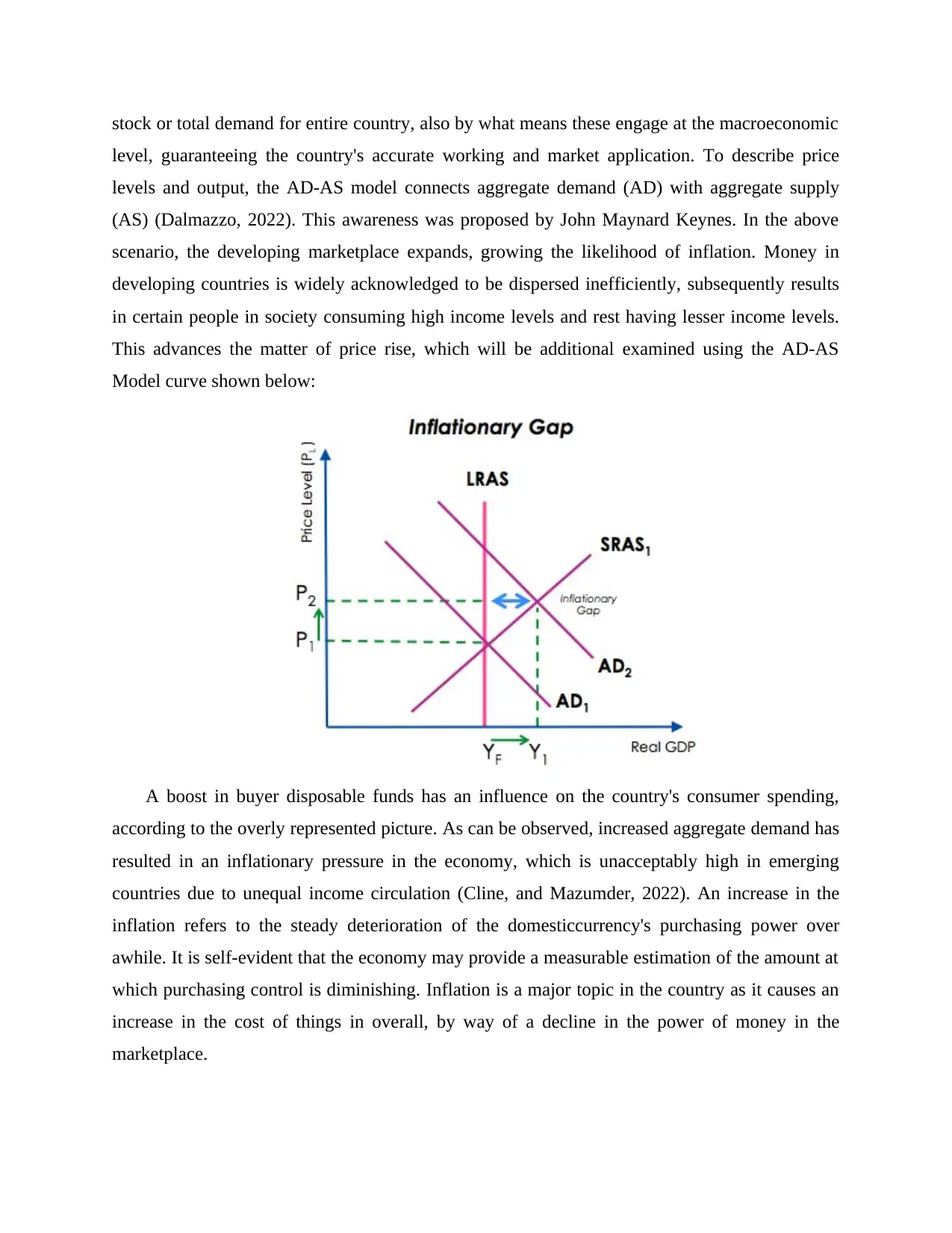
stock or total demand for entire country, also by what means these engage at the macroeconomic
level, guaranteeing the country's accurate working and market application. To describe price
levels and output, the AD-AS model connects aggregate demand (AD) with aggregate supply
(AS) (Dalmazzo, 2022). This awareness was proposed by John Maynard Keynes. In the above
scenario, the developing marketplace expands, growing the likelihood of inflation. Money in
developing countries is widely acknowledged to be dispersed inefficiently, subsequently results
in certain people in society consuming high income levels and rest having lesser income levels.
This advances the matter of price rise, which will be additional examined using the AD-AS
Model curve shown below:
A boost in buyer disposable funds has an influence on the country's consumer spending,
according to the overly represented picture. As can be observed, increased aggregate demand has
resulted in an inflationary pressure in the economy, which is unacceptably high in emerging
countries due to unequal income circulation (Cline, and Mazumder, 2022). An increase in the
inflation refers to the steady deterioration of the domesticcurrency's purchasing power over
awhile. It is self-evident that the economy may provide a measurable estimation of the amount at
which purchasing control is diminishing. Inflation is a major topic in the country as it causes an
increase in the cost of things in overall, by way of a decline in the power of money in the
marketplace.
level, guaranteeing the country's accurate working and market application. To describe price
levels and output, the AD-AS model connects aggregate demand (AD) with aggregate supply
(AS) (Dalmazzo, 2022). This awareness was proposed by John Maynard Keynes. In the above
scenario, the developing marketplace expands, growing the likelihood of inflation. Money in
developing countries is widely acknowledged to be dispersed inefficiently, subsequently results
in certain people in society consuming high income levels and rest having lesser income levels.
This advances the matter of price rise, which will be additional examined using the AD-AS
Model curve shown below:
A boost in buyer disposable funds has an influence on the country's consumer spending,
according to the overly represented picture. As can be observed, increased aggregate demand has
resulted in an inflationary pressure in the economy, which is unacceptably high in emerging
countries due to unequal income circulation (Cline, and Mazumder, 2022). An increase in the
inflation refers to the steady deterioration of the domesticcurrency's purchasing power over
awhile. It is self-evident that the economy may provide a measurable estimation of the amount at
which purchasing control is diminishing. Inflation is a major topic in the country as it causes an
increase in the cost of things in overall, by way of a decline in the power of money in the
marketplace.
Paraphrase This Document
Need a fresh take? Get an instant paraphrase of this document with our AI Paraphraser
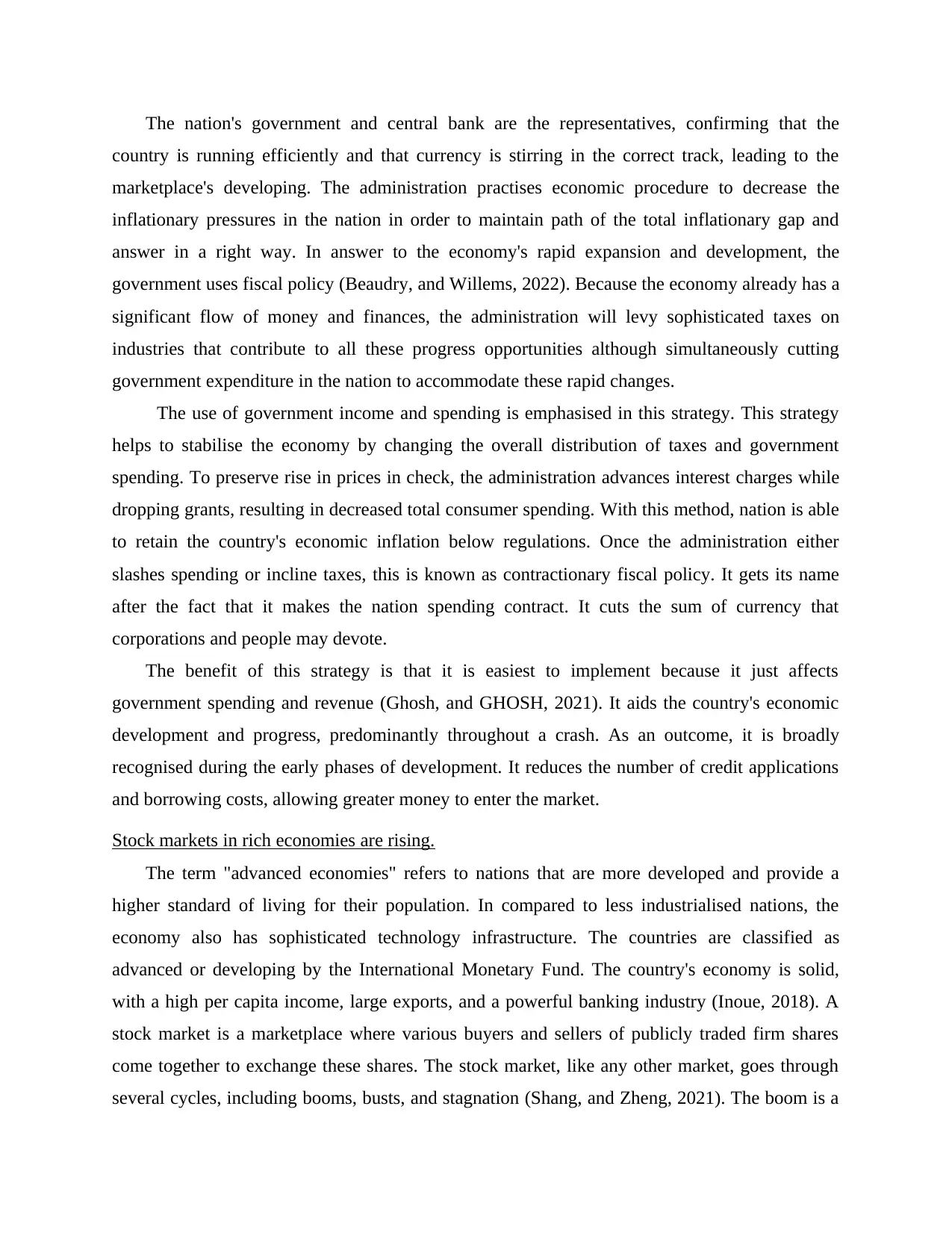
The nation's government and central bank are the representatives, confirming that the
country is running efficiently and that currency is stirring in the correct track, leading to the
marketplace's developing. The administration practises economic procedure to decrease the
inflationary pressures in the nation in order to maintain path of the total inflationary gap and
answer in a right way. In answer to the economy's rapid expansion and development, the
government uses fiscal policy (Beaudry, and Willems, 2022). Because the economy already has a
significant flow of money and finances, the administration will levy sophisticated taxes on
industries that contribute to all these progress opportunities although simultaneously cutting
government expenditure in the nation to accommodate these rapid changes.
The use of government income and spending is emphasised in this strategy. This strategy
helps to stabilise the economy by changing the overall distribution of taxes and government
spending. To preserve rise in prices in check, the administration advances interest charges while
dropping grants, resulting in decreased total consumer spending. With this method, nation is able
to retain the country's economic inflation below regulations. Once the administration either
slashes spending or incline taxes, this is known as contractionary fiscal policy. It gets its name
after the fact that it makes the nation spending contract. It cuts the sum of currency that
corporations and people may devote.
The benefit of this strategy is that it is easiest to implement because it just affects
government spending and revenue (Ghosh, and GHOSH, 2021). It aids the country's economic
development and progress, predominantly throughout a crash. As an outcome, it is broadly
recognised during the early phases of development. It reduces the number of credit applications
and borrowing costs, allowing greater money to enter the market.
Stock markets in rich economies are rising.
The term "advanced economies" refers to nations that are more developed and provide a
higher standard of living for their population. In compared to less industrialised nations, the
economy also has sophisticated technology infrastructure. The countries are classified as
advanced or developing by the International Monetary Fund. The country's economy is solid,
with a high per capita income, large exports, and a powerful banking industry (Inoue, 2018). A
stock market is a marketplace where various buyers and sellers of publicly traded firm shares
come together to exchange these shares. The stock market, like any other market, goes through
several cycles, including booms, busts, and stagnation (Shang, and Zheng, 2021). The boom is a
country is running efficiently and that currency is stirring in the correct track, leading to the
marketplace's developing. The administration practises economic procedure to decrease the
inflationary pressures in the nation in order to maintain path of the total inflationary gap and
answer in a right way. In answer to the economy's rapid expansion and development, the
government uses fiscal policy (Beaudry, and Willems, 2022). Because the economy already has a
significant flow of money and finances, the administration will levy sophisticated taxes on
industries that contribute to all these progress opportunities although simultaneously cutting
government expenditure in the nation to accommodate these rapid changes.
The use of government income and spending is emphasised in this strategy. This strategy
helps to stabilise the economy by changing the overall distribution of taxes and government
spending. To preserve rise in prices in check, the administration advances interest charges while
dropping grants, resulting in decreased total consumer spending. With this method, nation is able
to retain the country's economic inflation below regulations. Once the administration either
slashes spending or incline taxes, this is known as contractionary fiscal policy. It gets its name
after the fact that it makes the nation spending contract. It cuts the sum of currency that
corporations and people may devote.
The benefit of this strategy is that it is easiest to implement because it just affects
government spending and revenue (Ghosh, and GHOSH, 2021). It aids the country's economic
development and progress, predominantly throughout a crash. As an outcome, it is broadly
recognised during the early phases of development. It reduces the number of credit applications
and borrowing costs, allowing greater money to enter the market.
Stock markets in rich economies are rising.
The term "advanced economies" refers to nations that are more developed and provide a
higher standard of living for their population. In compared to less industrialised nations, the
economy also has sophisticated technology infrastructure. The countries are classified as
advanced or developing by the International Monetary Fund. The country's economy is solid,
with a high per capita income, large exports, and a powerful banking industry (Inoue, 2018). A
stock market is a marketplace where various buyers and sellers of publicly traded firm shares
come together to exchange these shares. The stock market, like any other market, goes through
several cycles, including booms, busts, and stagnation (Shang, and Zheng, 2021). The boom is a
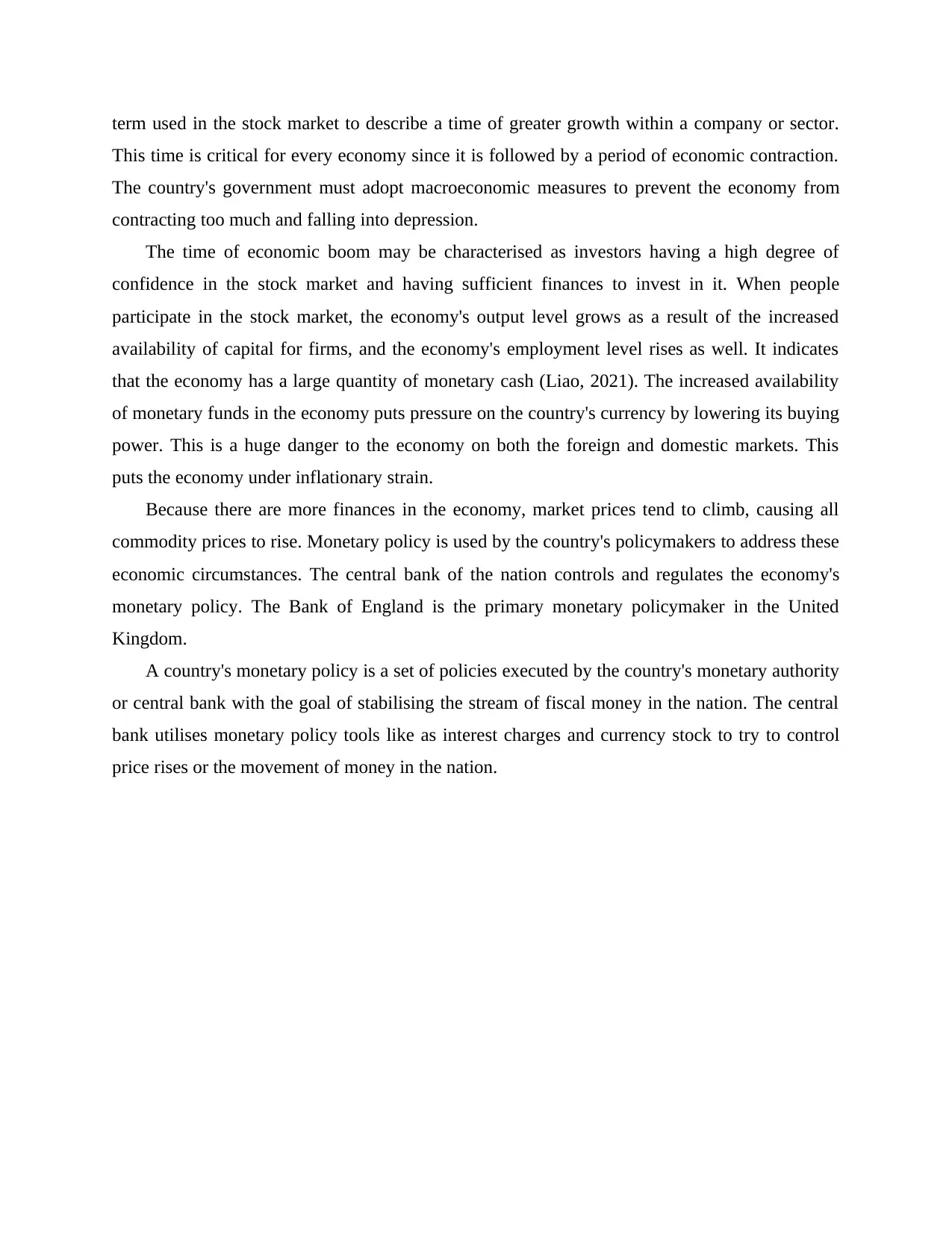
term used in the stock market to describe a time of greater growth within a company or sector.
This time is critical for every economy since it is followed by a period of economic contraction.
The country's government must adopt macroeconomic measures to prevent the economy from
contracting too much and falling into depression.
The time of economic boom may be characterised as investors having a high degree of
confidence in the stock market and having sufficient finances to invest in it. When people
participate in the stock market, the economy's output level grows as a result of the increased
availability of capital for firms, and the economy's employment level rises as well. It indicates
that the economy has a large quantity of monetary cash (Liao, 2021). The increased availability
of monetary funds in the economy puts pressure on the country's currency by lowering its buying
power. This is a huge danger to the economy on both the foreign and domestic markets. This
puts the economy under inflationary strain.
Because there are more finances in the economy, market prices tend to climb, causing all
commodity prices to rise. Monetary policy is used by the country's policymakers to address these
economic circumstances. The central bank of the nation controls and regulates the economy's
monetary policy. The Bank of England is the primary monetary policymaker in the United
Kingdom.
A country's monetary policy is a set of policies executed by the country's monetary authority
or central bank with the goal of stabilising the stream of fiscal money in the nation. The central
bank utilises monetary policy tools like as interest charges and currency stock to try to control
price rises or the movement of money in the nation.
This time is critical for every economy since it is followed by a period of economic contraction.
The country's government must adopt macroeconomic measures to prevent the economy from
contracting too much and falling into depression.
The time of economic boom may be characterised as investors having a high degree of
confidence in the stock market and having sufficient finances to invest in it. When people
participate in the stock market, the economy's output level grows as a result of the increased
availability of capital for firms, and the economy's employment level rises as well. It indicates
that the economy has a large quantity of monetary cash (Liao, 2021). The increased availability
of monetary funds in the economy puts pressure on the country's currency by lowering its buying
power. This is a huge danger to the economy on both the foreign and domestic markets. This
puts the economy under inflationary strain.
Because there are more finances in the economy, market prices tend to climb, causing all
commodity prices to rise. Monetary policy is used by the country's policymakers to address these
economic circumstances. The central bank of the nation controls and regulates the economy's
monetary policy. The Bank of England is the primary monetary policymaker in the United
Kingdom.
A country's monetary policy is a set of policies executed by the country's monetary authority
or central bank with the goal of stabilising the stream of fiscal money in the nation. The central
bank utilises monetary policy tools like as interest charges and currency stock to try to control
price rises or the movement of money in the nation.
⊘ This is a preview!⊘
Do you want full access?
Subscribe today to unlock all pages.

Trusted by 1+ million students worldwide
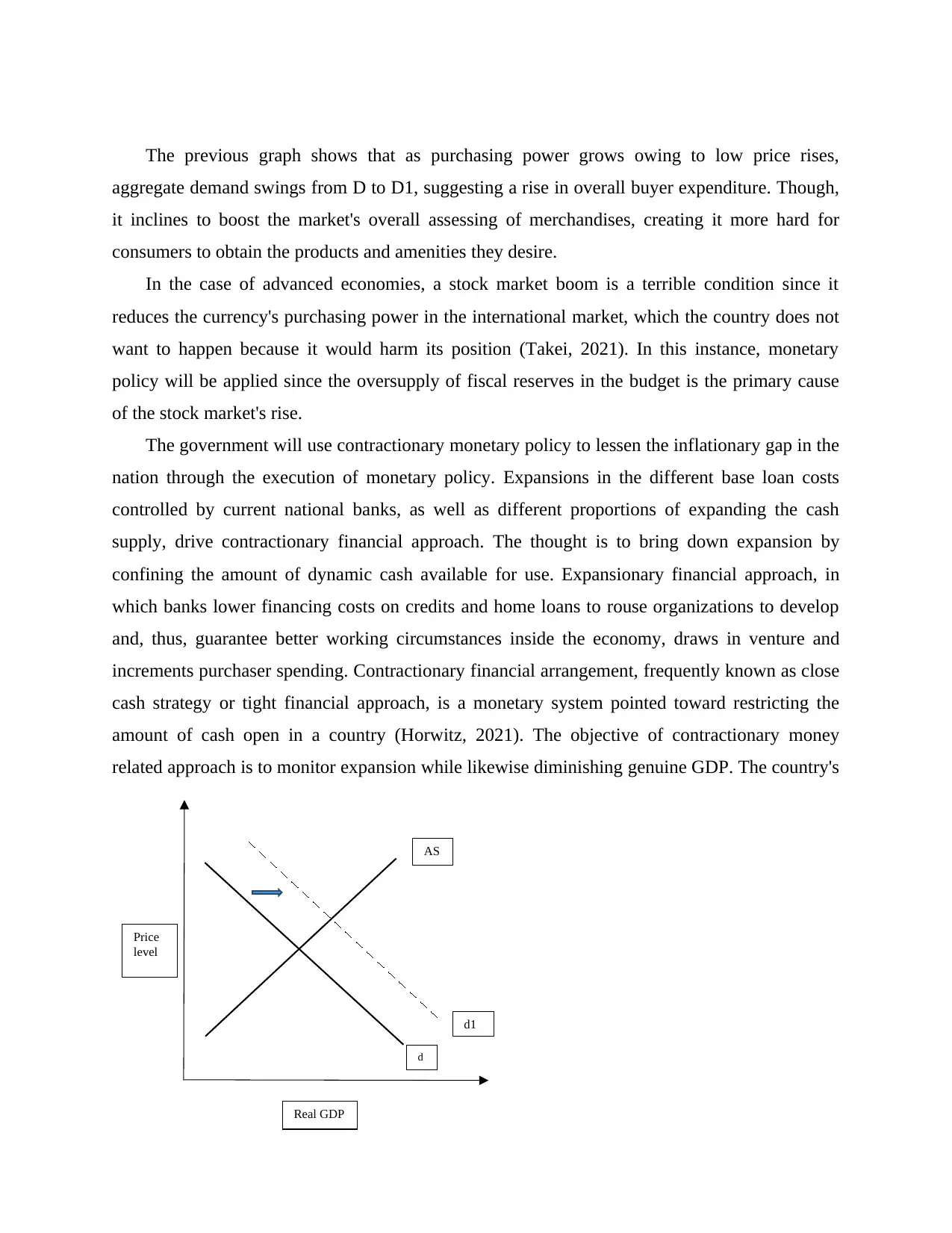
d
d1
AS
Price
level
Real GDP
The previous graph shows that as purchasing power grows owing to low price rises,
aggregate demand swings from D to D1, suggesting a rise in overall buyer expenditure. Though,
it inclines to boost the market's overall assessing of merchandises, creating it more hard for
consumers to obtain the products and amenities they desire.
In the case of advanced economies, a stock market boom is a terrible condition since it
reduces the currency's purchasing power in the international market, which the country does not
want to happen because it would harm its position (Takei, 2021). In this instance, monetary
policy will be applied since the oversupply of fiscal reserves in the budget is the primary cause
of the stock market's rise.
The government will use contractionary monetary policy to lessen the inflationary gap in the
nation through the execution of monetary policy. Expansions in the different base loan costs
controlled by current national banks, as well as different proportions of expanding the cash
supply, drive contractionary financial approach. The thought is to bring down expansion by
confining the amount of dynamic cash available for use. Expansionary financial approach, in
which banks lower financing costs on credits and home loans to rouse organizations to develop
and, thus, guarantee better working circumstances inside the economy, draws in venture and
increments purchaser spending. Contractionary financial arrangement, frequently known as close
cash strategy or tight financial approach, is a monetary system pointed toward restricting the
amount of cash open in a country (Horwitz, 2021). The objective of contractionary money
related approach is to monitor expansion while likewise diminishing genuine GDP. The country's
d1
AS
Price
level
Real GDP
The previous graph shows that as purchasing power grows owing to low price rises,
aggregate demand swings from D to D1, suggesting a rise in overall buyer expenditure. Though,
it inclines to boost the market's overall assessing of merchandises, creating it more hard for
consumers to obtain the products and amenities they desire.
In the case of advanced economies, a stock market boom is a terrible condition since it
reduces the currency's purchasing power in the international market, which the country does not
want to happen because it would harm its position (Takei, 2021). In this instance, monetary
policy will be applied since the oversupply of fiscal reserves in the budget is the primary cause
of the stock market's rise.
The government will use contractionary monetary policy to lessen the inflationary gap in the
nation through the execution of monetary policy. Expansions in the different base loan costs
controlled by current national banks, as well as different proportions of expanding the cash
supply, drive contractionary financial approach. The thought is to bring down expansion by
confining the amount of dynamic cash available for use. Expansionary financial approach, in
which banks lower financing costs on credits and home loans to rouse organizations to develop
and, thus, guarantee better working circumstances inside the economy, draws in venture and
increments purchaser spending. Contractionary financial arrangement, frequently known as close
cash strategy or tight financial approach, is a monetary system pointed toward restricting the
amount of cash open in a country (Horwitz, 2021). The objective of contractionary money
related approach is to monitor expansion while likewise diminishing genuine GDP. The country's
Paraphrase This Document
Need a fresh take? Get an instant paraphrase of this document with our AI Paraphraser
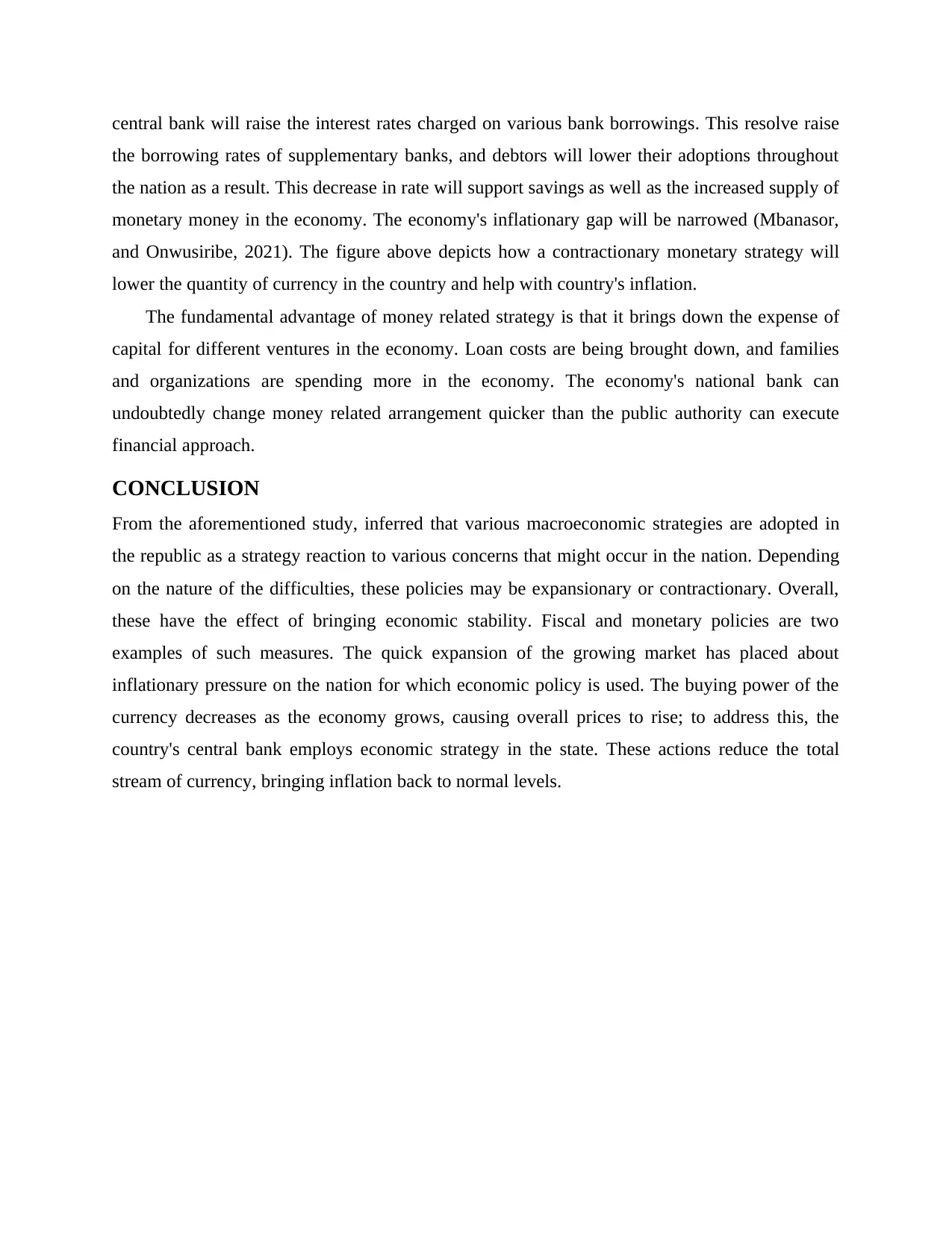
central bank will raise the interest rates charged on various bank borrowings. This resolve raise
the borrowing rates of supplementary banks, and debtors will lower their adoptions throughout
the nation as a result. This decrease in rate will support savings as well as the increased supply of
monetary money in the economy. The economy's inflationary gap will be narrowed (Mbanasor,
and Onwusiribe, 2021). The figure above depicts how a contractionary monetary strategy will
lower the quantity of currency in the country and help with country's inflation.
The fundamental advantage of money related strategy is that it brings down the expense of
capital for different ventures in the economy. Loan costs are being brought down, and families
and organizations are spending more in the economy. The economy's national bank can
undoubtedly change money related arrangement quicker than the public authority can execute
financial approach.
CONCLUSION
From the aforementioned study, inferred that various macroeconomic strategies are adopted in
the republic as a strategy reaction to various concerns that might occur in the nation. Depending
on the nature of the difficulties, these policies may be expansionary or contractionary. Overall,
these have the effect of bringing economic stability. Fiscal and monetary policies are two
examples of such measures. The quick expansion of the growing market has placed about
inflationary pressure on the nation for which economic policy is used. The buying power of the
currency decreases as the economy grows, causing overall prices to rise; to address this, the
country's central bank employs economic strategy in the state. These actions reduce the total
stream of currency, bringing inflation back to normal levels.
the borrowing rates of supplementary banks, and debtors will lower their adoptions throughout
the nation as a result. This decrease in rate will support savings as well as the increased supply of
monetary money in the economy. The economy's inflationary gap will be narrowed (Mbanasor,
and Onwusiribe, 2021). The figure above depicts how a contractionary monetary strategy will
lower the quantity of currency in the country and help with country's inflation.
The fundamental advantage of money related strategy is that it brings down the expense of
capital for different ventures in the economy. Loan costs are being brought down, and families
and organizations are spending more in the economy. The economy's national bank can
undoubtedly change money related arrangement quicker than the public authority can execute
financial approach.
CONCLUSION
From the aforementioned study, inferred that various macroeconomic strategies are adopted in
the republic as a strategy reaction to various concerns that might occur in the nation. Depending
on the nature of the difficulties, these policies may be expansionary or contractionary. Overall,
these have the effect of bringing economic stability. Fiscal and monetary policies are two
examples of such measures. The quick expansion of the growing market has placed about
inflationary pressure on the nation for which economic policy is used. The buying power of the
currency decreases as the economy grows, causing overall prices to rise; to address this, the
country's central bank employs economic strategy in the state. These actions reduce the total
stream of currency, bringing inflation back to normal levels.
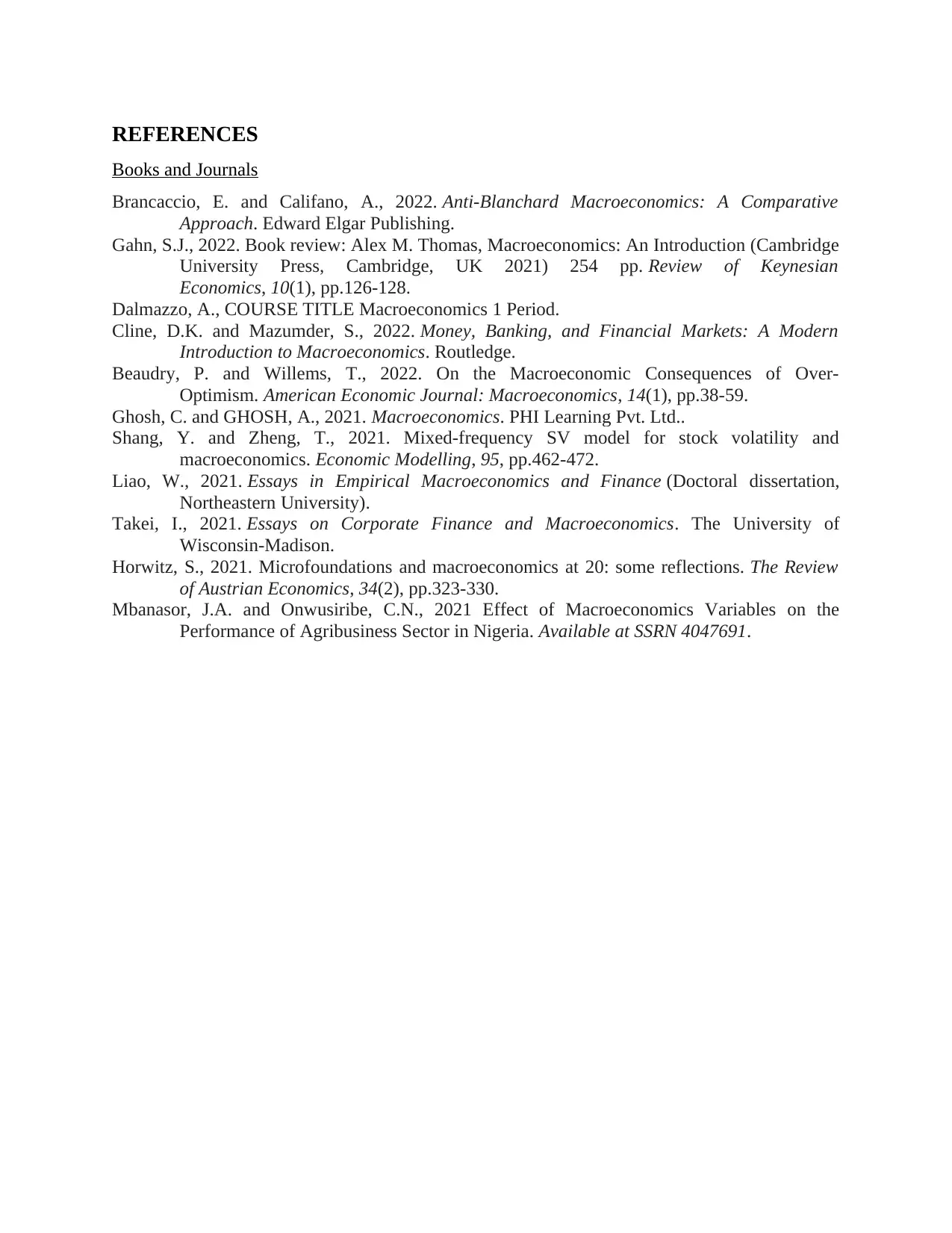
REFERENCES
Books and Journals
Brancaccio, E. and Califano, A., 2022. Anti-Blanchard Macroeconomics: A Comparative
Approach. Edward Elgar Publishing.
Gahn, S.J., 2022. Book review: Alex M. Thomas, Macroeconomics: An Introduction (Cambridge
University Press, Cambridge, UK 2021) 254 pp. Review of Keynesian
Economics, 10(1), pp.126-128.
Dalmazzo, A., COURSE TITLE Macroeconomics 1 Period.
Cline, D.K. and Mazumder, S., 2022. Money, Banking, and Financial Markets: A Modern
Introduction to Macroeconomics. Routledge.
Beaudry, P. and Willems, T., 2022. On the Macroeconomic Consequences of Over-
Optimism. American Economic Journal: Macroeconomics, 14(1), pp.38-59.
Ghosh, C. and GHOSH, A., 2021. Macroeconomics. PHI Learning Pvt. Ltd..
Shang, Y. and Zheng, T., 2021. Mixed-frequency SV model for stock volatility and
macroeconomics. Economic Modelling, 95, pp.462-472.
Liao, W., 2021. Essays in Empirical Macroeconomics and Finance (Doctoral dissertation,
Northeastern University).
Takei, I., 2021. Essays on Corporate Finance and Macroeconomics. The University of
Wisconsin-Madison.
Horwitz, S., 2021. Microfoundations and macroeconomics at 20: some reflections. The Review
of Austrian Economics, 34(2), pp.323-330.
Mbanasor, J.A. and Onwusiribe, C.N., 2021 Effect of Macroeconomics Variables on the
Performance of Agribusiness Sector in Nigeria. Available at SSRN 4047691.
Books and Journals
Brancaccio, E. and Califano, A., 2022. Anti-Blanchard Macroeconomics: A Comparative
Approach. Edward Elgar Publishing.
Gahn, S.J., 2022. Book review: Alex M. Thomas, Macroeconomics: An Introduction (Cambridge
University Press, Cambridge, UK 2021) 254 pp. Review of Keynesian
Economics, 10(1), pp.126-128.
Dalmazzo, A., COURSE TITLE Macroeconomics 1 Period.
Cline, D.K. and Mazumder, S., 2022. Money, Banking, and Financial Markets: A Modern
Introduction to Macroeconomics. Routledge.
Beaudry, P. and Willems, T., 2022. On the Macroeconomic Consequences of Over-
Optimism. American Economic Journal: Macroeconomics, 14(1), pp.38-59.
Ghosh, C. and GHOSH, A., 2021. Macroeconomics. PHI Learning Pvt. Ltd..
Shang, Y. and Zheng, T., 2021. Mixed-frequency SV model for stock volatility and
macroeconomics. Economic Modelling, 95, pp.462-472.
Liao, W., 2021. Essays in Empirical Macroeconomics and Finance (Doctoral dissertation,
Northeastern University).
Takei, I., 2021. Essays on Corporate Finance and Macroeconomics. The University of
Wisconsin-Madison.
Horwitz, S., 2021. Microfoundations and macroeconomics at 20: some reflections. The Review
of Austrian Economics, 34(2), pp.323-330.
Mbanasor, J.A. and Onwusiribe, C.N., 2021 Effect of Macroeconomics Variables on the
Performance of Agribusiness Sector in Nigeria. Available at SSRN 4047691.
⊘ This is a preview!⊘
Do you want full access?
Subscribe today to unlock all pages.

Trusted by 1+ million students worldwide
1 out of 9
Related Documents
Your All-in-One AI-Powered Toolkit for Academic Success.
+13062052269
info@desklib.com
Available 24*7 on WhatsApp / Email
![[object Object]](/_next/static/media/star-bottom.7253800d.svg)
Unlock your academic potential
Copyright © 2020–2025 A2Z Services. All Rights Reserved. Developed and managed by ZUCOL.


